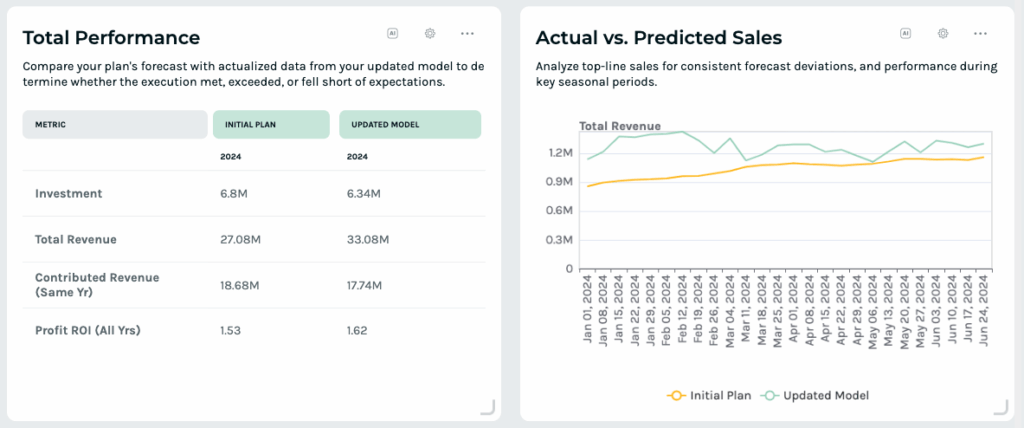Performance marketing agencies are under pressure to “become data-driven,” but adopting AI tools is a cultural and operational shift, not a plug-and-play fix.
The challenge is not the tech that slows things down, but the pushback from the people without an effective AI change management process.
This blog explains how you can implement artificial intelligence change management across your teams without friction, resistance, or false starts.
Key highlights:
- Most performance marketing agencies struggle with artificial intelligence (AI) change management because the real challenge is shifting team behavior, not installing new tools.
- AI change management strategies fall apart when there’s no cross-functional buy-in, role clarity, or workflow integration.
- Successful AI adoption and change management strategies focus on pain points, involve every team early, and evolve through feedback.
- AI-powered platforms like Keen help agencies turn change management strategy into action with scenario planning, explainable forecasts, and fast operationalization.
What is AI change management?
AI change management is the process of helping your team adopt and consistently use AI tools in day-to-day workflows. It’s the only way to drive consistent usage of the AI tools across your operations.
Without a clear change management process, new AI tools end up sitting in a dashboard collecting dust. With the right approach, they become part of how your agency operates, helping you create media plans, forecast, and pivot faster.
What is a change management strategy for AI adoption?
A change management strategy for AI adoption is the plan for how you introduce AI technology into your operations and workflows, and get your team to actually use the tools. The goal is to get the team on board and change the way decisions are made.
An effective change management strategy tackles the internal blockers that slow teams down:
- Unclear roles
- Siloed data
- Mistrust in automation
- Lack of ownership
Read more: A guide to using AI in media planning
Why agencies need an artificial intelligence change management process
AI marketing tools or any other new technology, for that matter, don’t fail because they’re inaccurate. They fail because no one knows how to use them effectively, or worse, no one wants to. You can have the best tech stack and marketing strategy software, but if you don’t have a change management process in place, it won’t be used to its full potential.
AI adoption blockers
Without an AI change management strategy in place, most tech rollouts hit the same blockers:
- Tool usage stays surface-level: AI insights live in dashboards, but never drive action.
- Teams resist what they don’t understand: Without clear roles or context, people hesitate or push back. In fact, according to Gallup research, 70% of US employees don’t use AI tools at work at all.
- Fear of job loss stalls adoption: When AI is introduced without transparency, it induces anxiety about being replaced, leading to resistance and a lack of engagement. For example, 87% of respondents in an Ericsson study said people and culture challenges were a bigger barrier to AI adoption than the technology itself.
- Decisions slow down instead of speeding up: No one knows who’s responsible for what when the model recommends a change.
- Client confidence drops: If nothing actually changes in execution after you integrate AI, clients won’t see the value of your new “AI-powered” approach.
Benefits of an effective AI change management strategy
A solid change management strategy turns AI from a tool into a workflow with:
- Cross-functional adoption: Everyone, from media to strategy to client services, knows their role.
- Clear decision-making workflows: AI enhances data-driven decision-making with forecasts that lead to real action, not confusion or delays.
- Trust in the model: When the AI integration process makes sense, your team stops questioning and starts executing.
- Scalable transformation with AI: You don’t just adopt AI; you operationalize it across the agency.
Read more: The future of marketing technology
7 reasons most strategies for change management fall apart
Using AI in marketing sounds exciting—until you try to do it and it fails. You’re not alone in the struggle, either. According to a BCG report, 74% of companies struggle to achieve AI adoption at scale.
- No clear tie to ad campaigns or client pain points: Teams don’t understand the purpose of the tool or the problem it’s solving. Without a purpose, the AI initiative feels like another top-down change.
- Undefined roles and decision rights: When the model recommends a spend shift or channel adjustment, no one knows who’s responsible. Is it the media buyer? The strategist? The account lead? Without a decision chain, insights die in the dashboard.
- Data-driven insights live outside the campaign workflow: AI outputs are delivered in decks or dashboards no one uses instead of being integrated into daily routines. If the tool isn’t integrated into briefs, post-mortems, or client reporting, it doesn’t get used.
- AI adoption is treated like a one-time event: Many agencies roll out AI with a single demo or workshop, then never follow up. You need recurring guidance, process updates, and reinforcement to make the tool work.
- Change is top-down with no buy-in: When leadership introduces AI without involving media, strategy, or client teams early, adoption stalls. People are less likely to trust or use tools they didn’t help shape.
- Past tools created skepticism: If your agency has tried and abandoned AI technologies before, expect hesitation. People remember when platforms overpromised, underdelivered, or added complexity instead of clarity.
- No KPIs for adoption success: If there’s no plan to measure if AI is improving ROAS, speeding up decisions, or being used in planning, there’s no accountability.
How to implement AI and change management in marketing
Getting people to actually use your new tech rollout needs a shift in how your agency makes decisions. Use the following 5-step change management process to lead the AI shift.
1. Tie the AI tool to specific media campaign pain points
Nobody wants another “artificial intelligence.” They want fewer performance surprises and fewer 10 p.m. reallocation scrambles.
If your team’s stuck reacting instead of planning, show how AI helps them shift from firefighting to foresight.
How to ground the AI rollout with real campaign pain points
- Find a problem your team already feels: Look for recurring frustrations like delayed reallocations, unclear optimization direction, or reactive campaign pivots.
- Use a past campaign as a case study: Reconstruct how a forecast or earlier insight could’ve changed the outcome.
- Frame AI as a fix, not a feature: Position the tool as a direct answer to a known issue, not as a futuristic upgrade the team didn’t ask for.
For example, Keen uses predictive analytics in marketing to help you forecast media reallocations before the client request hits Slack.

2. Involve every team involved in paid media strategy
AI-driven insights don’t stop at the media plan. If your strategy doesn’t validate the ideas, and account leads can’t explain them for better customer experiences, nothing moves. Your AI change management process has to be cross-functional from the start, or the adoption fails by default.
How to get your paid media and client teams aligned from day one
- Invite every key function to the table: Include strategy, media, client services, content creation, and ops—anyone who touches performance or client conversations.
- Workshop a real marketing decision-making scenario: Run through an example (for example, reallocating spend from Meta to YouTube) and map how each team responds. Such an activity will also help team members identify areas where they can use the tool realistically.
- Document shared responsibilities: Define who owns what and make sure it’s visible in planning docs, briefs, or your PM tool.
Read more: How AI can bridge the value gap between marketing and finance
3. Define clear roles for strategy, media, and client teams
When the AI flags a shift in spend or channel mix, who owns the call? Who vets it? Who presents it to the client? If no one knows, nothing happens. Define roles before you expect adoption.
How to clarify ownership inside your agency
- Decide who selects the AI tool in the first place: Tool selection is often a political and strategic decision, especially in agencies where different teams may have different needs or preferences. Involve media, strategy, and analytics leads early so the selected platform fits real workflow needs, not just executive preferences or vendor hype.
- Map the decision path step by step: Start with “Who sees the insight first?” and end with “Who delivers the update to the client?”
- Spell out what stays human: Be explicit about what’s supported by the AI tool versus what still requires human strategy, client context, or approval.
- Write it into the workflow: Don’t leave this informal. Add roles and handoffs to your campaign processes, playbooks, and briefs.
Read more: Use AI to build a high-performance marketing team
4. Build trust in the model across media and analytics teams
Your team doesn’t need help clicking buttons. They need to trust what the model is telling them, so they don’t resort to relying on marketing instincts. If they can’t validate the logic or challenge the output, they won’t act on it.
How to get media and analytics teams to trust the model
- Run side-by-side comparisons with real data: “Here’s what we did and here’s what the model would’ve recommended.”
- Celebrate wins with specifics: Highlight examples where following AI insights led to measurable gains (for example, saved spend, improved ROAS, faster pivots).
- Normalize gut checks and skepticism: Create space for healthy pushback. Trust builds faster when the team feels ownership over the outcome.
Read more: 8 reasons to trust the Keen platform
5. Make feedback part of the media planning workflow
If there’s no process to surface friction, your team will quietly revert to the old way of doing things. Feedback isn’t a nice-to-have; it’s how AI adoption evolves from trial to habit.
How to make AI stick inside your media planning process
- Build a short, recurring feedback loop: Add a 10–15 minute discussion to existing weekly or monthly meetings to flag what’s working or unclear.
- Act visibly on feedback: Show the team how their input led to a change in workflow, roles, or documentation.
- Highlight wins that tie back to the tool: Share client results, process improvements, or faster decisions that came directly from data-driven media planning.
Put your change management AI strategy into action with Keen
Adopting artificial intelligence tools doesn’t transform your agency. Leading change does.
You can’t expect your team to shift from campaign executors to strategic advisors unless the workflows, roles, and decision-making structure evolve with them. That’s why AI change management in marketing can’t be an afterthought.
This is where the Keen platform for agencies helps.
Our AI-powered MMM platform gives your team the foresight to make confident media decisions and the clarity to align around them. More importantly, it reinforces your AI adoption in marketing by being:
- Explainable: Strategists and media buyers trust the output, not just read it.
- Scenario-based: Teams can test options before taking action.
- Easy to integrate across channels: Your tech stack doesn’t have to change and you’re not optimizing in silos.
- Fast to operationalize: Change management doesn’t turn into a six-month consulting project.
Request a demo to see how you can easily adopt Keen with a smoother AI change management process.





